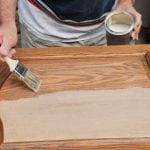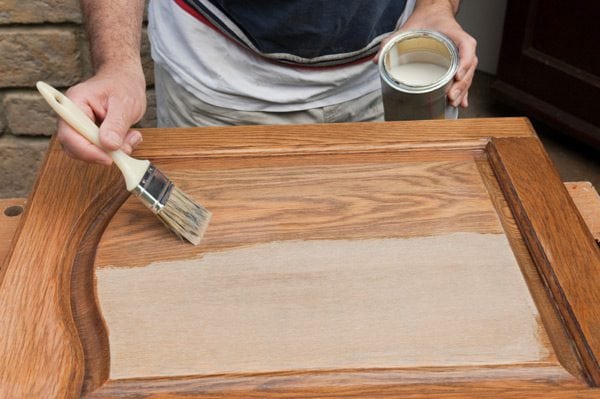Wood has always been a favorite material of man. No synthetic material can compete with the natural, diverse beauty of wood. The strict simplicity of the oak, the exquisite airiness of the Karelian birch - how many different species of trees, so many warm shades of wood, surprisingly beautiful patterns, which in themselves can decorate any interior in the form of a door, furniture, parquet.
But wooden surfaces even with proper care without reliable protection darken, collapse, are affected by fungus, mold. A worthy way out of this situation is the use of a colorless or tint varnish, which favorably emphasizes the texture of the tree, expressively shades the natural beauty of the product. But before applying it, it is necessary to use a primer, the use of which:
- will provide uniform distribution of the finish coating without streaks, sagging;
- eliminate bumps, cracks;
- protects the product from adverse environmental factors;
- emphasizes natural beauty;
- will make it durable.
What is a primer mix
Having visited the construction market, a little bewildered by the variety of goods offered there, the layman sometimes succumbs to persuasion of sellers who advertise their goods as universal, and can miscalculate with a purchase. To prevent this from happening, you need to decide before and after going to the market why and for what purpose the primer will be purchased. Its composition largely depends on this.
Primer application objectives may include the following:
- smoothing irregularities before subsequent application of varnish;
- restoration of old parquet or wooden floor;
- the desire to emphasize the texture of wood, to give brightness to its pattern;
- increase the shade of panels or parquet;
- protect the product from the risk of darkening;
- increase the resistance of parquet to wear;
- protect wood from adverse environmental conditions, fungi, rot - this most often applies to wooden products for street use: arbors, terraces.
Varieties in composition
When choosing a composition, one should take into account not only the protective and toxic qualities of the primer, but also the characteristics of the varnish that will be applied after this, at the final stage of work.
Types of primer for the main substance:
- Alkydnaya is best liked by professional builders, it is considered the best. The wood processed by it dries up to 18 hours, on its surface a matte dense protective film is formed, which emphasizes the structure. Such a primer is non-toxic. Using it, you can significantly increase the wear resistance of parquet or wooden plank floor.
- Water-dispersion and its variety - acrylic - dry quickly. They are odorless, non-toxic. Treated with such a composition, the wood is easily polished, protected from rot, mold.
- Shellac.It is most often used for processing raw or poorly dried wood, consists of methyl alcohol and insect milky juice. It has pronounced protective properties.
Processing Features
Primed wood surface before applying varnish on it can be in many ways. Applicable:
- liquid wax, which is sold in aerosol cans;
- natural wax dissolved in turpentine base;
- an aqueous solution of well sifted crushed chalk, into which, to add the desired shade, you can add a dye;
- a mixture of wood powder and PVA glue.
How to choose a primer taking into account the topcoat:
- if in the future we will use varnish based on a solvent or polyurethane, then the primer must necessarily include a solvent.
- when using water-dispersion varnishes, it is necessary to use an acrylic or other (for example, chalk) water-based primer.
to contents ↑Tip: when it is necessary that the door, panels, parquet retain their natural color, it is necessary to take a colorless primer.
Before priming
In order for the wood, first coated with a primer, and then with varnish, to look spectacular and serve for a long time, it must be properly prepared and stocked with the necessary tools.
Of the tools required:
- a set of abrasive paper ("skins") of different grain sizes;
- rubber plate of small size;
- rectangular block, the size of which depends on the surface being machined.
Having stocked up the tool, you can begin the preparatory work. All wooden surfaces are treated with a “skin” by smoothly moving it along the wood fibers. It is necessary to gradually change the granularity from large to smaller. For processing large areas (such as parquet, panels) it is more convenient to wrap a block of the required size with abrasive paper, for smaller parts (furniture elements) - wrap a rubber plate.
Tip: Fine dust, wood shavings are most convenient to collect with a vacuum cleaner. After thorough processing and cleaning of the surface, you can begin to apply the primer.
to contents ↑How to primer
The surface of the parquet, floor, door, panels, furniture is already carefully aligned, cleaned of dust and debris, dried, now you can proceed to the intermediate step before applying the varnish - priming.
- First you need to pour the solution into a convenient container. When using the concentrate, dilute it with water or a solvent according to the instructions.
- Primer should be uniformly applied using a roller or brush, depending on the surface. Apply the solution to the surface along the wood fibers.
- After the first coat of primer dries, it is necessary to “sand away” the wood fibers to a smooth surface, if necessary (when restoring old parquet, panels), use wood putty.
- On top, apply another 1-2 layers of the composition.
- After complete drying, you can begin the finishing stage: cover the product with tint or colorless varnish.
It is important not to save on the primer. The extra few layers of the coating increase the quality of the finish and achieve the desired effect.
After priming and complete drying of the last layer, the tree is covered with a tint or colorless varnish 2-3 times. It is necessary to apply the finish coating with a very thin layer, without streaks and stains.
Compliance with the right technology at all stages: preparation, priming, varnishing can ensure that the wooden floor, door, parquet retain their original appearance for a long time, will delight with their warm, artistically accentuated texture, creating a cozy atmosphere in the house.










